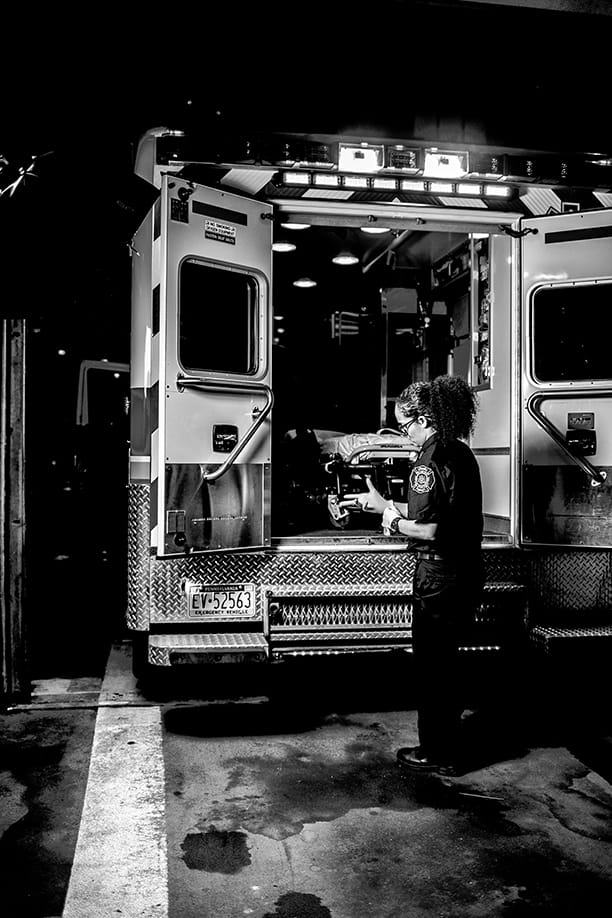Drexel Research Group Developing New Checklist to Prevent Violence Against Ambulance Workers
 By Frank Otto
By Frank Otto

- Drexel Selects New, World-Class Life Sciences Building at 3201 Cuthbert Street for Medical Research Operations
- Breakthrough on Gene Therapy for Hereditary Spastic Paraplegia
- Drexel Environmental Collaboratory Releases Cross-Sector Findings on Severe Weather Recovery Challenges
- Drexel Launches the Manuel Stamatakis Center for Alternative Investments at the LeBow College of Business

In one moment, Ben Vernon was walking up to a routine call. In the next, he was struggling to breathe after an attacker with a knife put a hole in his lung.
Almost three years after that terrifying incident, Vernon is speaking before a conference where Drexel University researchers are hoping to finalize a checklist to help medics like him recover from — and ultimately avoid — on-the-job attacks.
For two days, July 16 and 17, representatives from fire departments with EMS services across the country will converge on Drexel to finalize the checklist. Hosted by the Center for Firefighter Injury Research and Safety Trends (FIRST), which is run by the Dornsife School of Public Health’s Jennifer Taylor, PhD, the conference’s goal is to get a system-level checklist that fire departments can use to examine their processes in the goal of identifying, assessing and, preventing violence against EMS personnel.
“The checklist will provide everything from training on what to expect on the job, to communication innovations, to after-care for physical — and mental — injuries,” Taylor said. “It has a large emphasis on policy development and training so that members feel prepared and supported.”

For example, one part of the checklist asks departments whether they have a system in place to flag certain locations where violence against first-responders has occurred in the past. If so, it then asks that dispatchers be trained to warn crews heading to the scene of the hazard so that they’re prepared.
Other parts of the checklist cover how departments might manage the aftermath of a violent attack, including strategies for mindfully handling lingering anxiety and stress.
Taking such precautions is of the utmost importance because medics in fire departments are 14 times more likely to be violently injured on the job than their firefighter colleagues, past research by FIRST found.
“I think workers downplay this violence and the community doesn’t know about it and the stress that it causes,” Taylor explained. “Workers have internalized the belief that getting attacked is ‘part of the job’ because nothing has changed for so long and no one had been paying attention to their plight.”
Attacks on medics like the one Vernon survived often blindside them, so Taylor and her team strived to develop something that gets these crews more prepared, and build up the system around them to better deal with it.
Alongside Vernon at the conference will be Kelly Adams, who survived an attack similar to his while on a call in Detroit.

Adams and her partner were treating a woman’s injured ankle and were both stabbed in the face and neck area by the patient’s boyfriend when he became enraged that he couldn’t ride along in the ambulance with them.
Both Vernon and Adams will provide perspective as those at the conference discuss and polish the checklist. In addition to FIRST members, representatives from FEMA (which funded the checklist’s development), the Philadelphia, Chicago and San Diego fire departments, and organizations like the International Association of Fire Chiefs and the International Association of Firefighters will be on hand at the conference.
Once it is over, attendees from the three municipal fire departments will bring back the checklist to their firehouses to test it out and determine how well it addresses the violence, stress and anxiety that too many EMS workers deal with on the job.
“We will be working closely with the Philadelphia, Chicago and San Diego fire departments to study how the implement the checklist and the difference it makes for their members,” Taylor said. “We anticipate that it will improve morale, decrease burnout and inspire greater communication between leadership and the rank and file on the issue of workplace stress and violence.”
Taylor and her team have high hopes for the checklist and would love for it to go national and international.
“My hope is that the organizations for whom the medics work will take a long look inside to see what more they can be doing to have the backs of their workers out in the community doing such demanding and hazardous work,” she said. “Oftentimes, we put the onus on the worker and not the organization. And, often, this doesn’t get talked about unless something really bad happens.”
“We need to change that.”
In This Article
Contact
Drexel News is produced by
University Marketing and Communications.